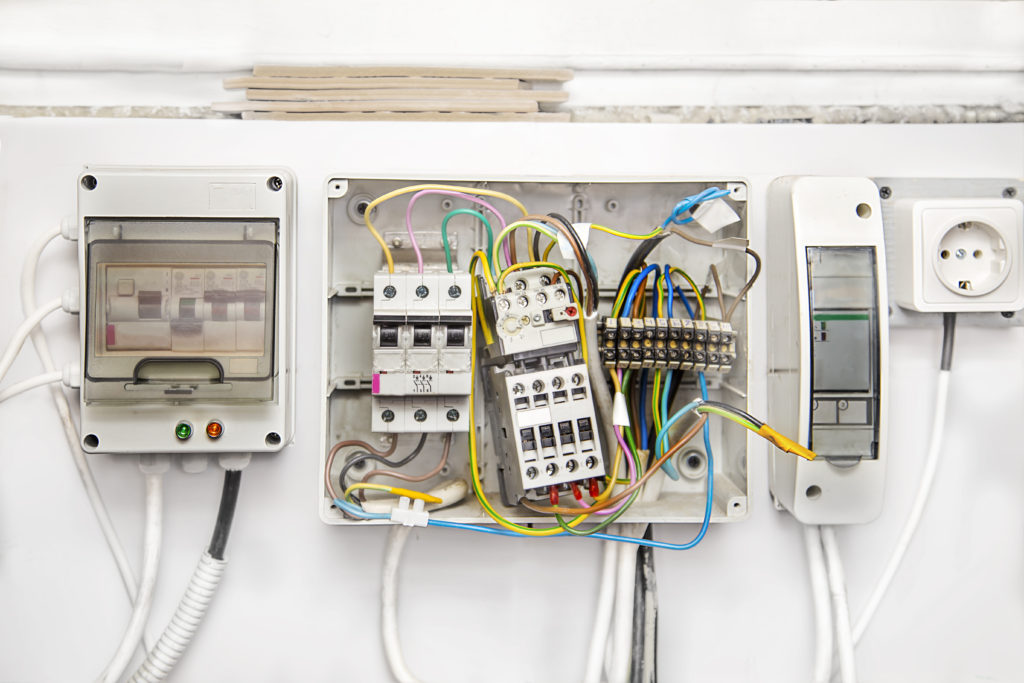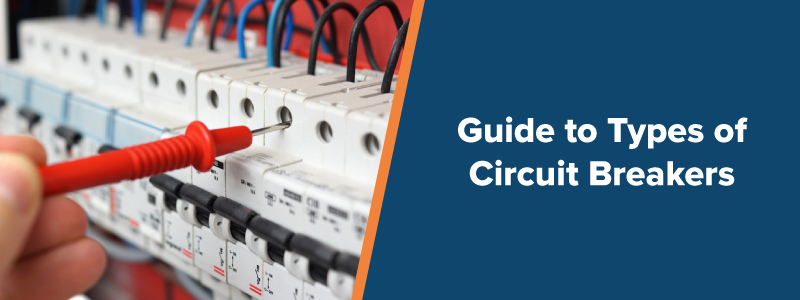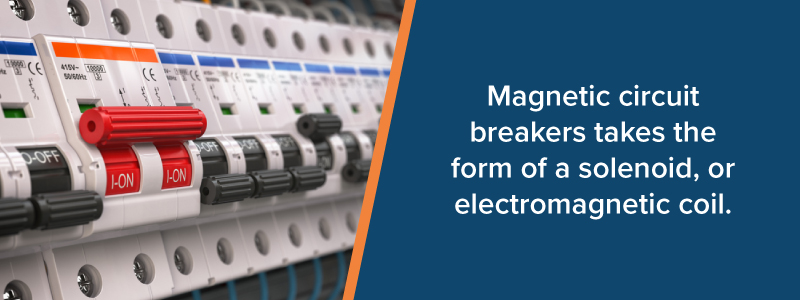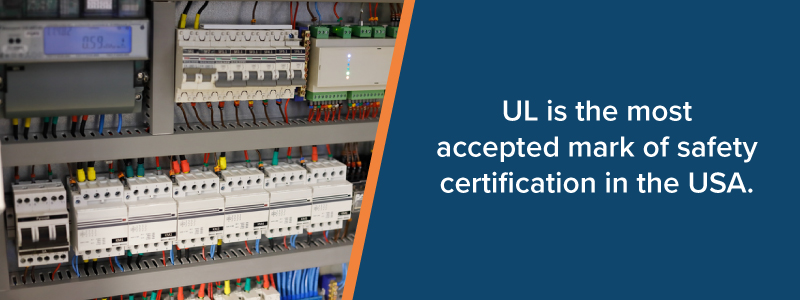Guide to Types of Circuit Breakers


A circuit breaker is an automatic electrical shutoff switch that protects circuits from overcurrent. Overcurrent, or excess amperage, can come from an overload of the circuit, short-circuiting, an arc fault or a ground fault. Circuit breakers make use of the increased heat or magnetic field from the current and use it to trip the circuit.
Circuit breakers have been in widespread use for nearly a century and are one of the most important fire safety tools in modern homes, buildings and appliances. Although they perform the same essential function as a fuse, they have the benefit of not needing to be replaced when overcurrent occurs, which saves money and allows for quick fixes.
In this article, we will take a look at the different types of circuit breakers and what applications they’re best suited for. They vary according to what class of voltage they handle, how they’re constructed, what type of interruption they offer and what type of structural attributes they feature.
Low-Voltage Circuit Breakers
These are one of the most common types of circuit breaker on the market and can be found in homes, businesses and industries. They include the following models:
- Miniature Circuit Breakers (MCB): Miniature Circuit Breakers do not handle currents higher than 100 amps, which makes them suitable for many home and business applications. Once installed, they’re simple to use but not very tunable — you can’t usually adjust their trip settings, for instance. They operate on thermal or thermal-magnetic properties.
- Molded Case Circuit Breakers (MCCB): These circuit breakers can handle currents up to 2,500 amps, making them a more robust choice for higher-power residential and industrial purposes. With higher amp ratings, their trip load can typically be tuned.
What is the difference between MCB and MCCB circuit breakers? MCCBs can handle more voltage, and because of the different requirements set on them, they come in different casing and with different components.
Low-voltage circuit breakers are designed to be easily serviced. They’re often easily disassembled for repairs without a user having to take the switchgear apart. Some assemblies are automatic, allowing an operator to open and close them remotely. These circuit breakers can also be used on direct current applications. Because direct current’s internal electrical arc does not stop and start as with alternating current, a different type of breaker must be used within the unit. Their parts may include the following:
- Lever: The actuator lever is the part that is visible to the user. When the circuit is tripped, this lever flips and must be manually flipped back to close the circuit again. Note that most levers can still trip even when locked in position — an important safety feature.
- Actuator mechanism: This part presses the contacts together or forces them apart. It’s controlled by both the internal mechanisms and the lever.
- Contacts: Each contact is one end of the circuit. The circuit is closed when they are together and is open when they are apart.
- Terminals: Terminals are where the breaker connects to the rest of the circuit.
- Bimetallic strip: These components are the thermal elements of circuit breakers. The bimetallic strip absorbs heat from the passing current, and if the current grows too high, it will heat up and bend. This process separates the ends of the circuit, which is especially useful for catching systematic, long-term overcurrents, as the bimetallic strip takes longer to trip the circuit than a magnetic element.
- Screw for calibration: The manufacturer can adjust the amount of current the breaker can handle using this screw.
- Solenoid: This device utilizes the electromagnetic force to trip circuits.
- Arc divider and extinguisher: This component offers the means by which the circuit breaker extinguishes the arc of current between the contacts. It varies in different types of circuit breakers, but low-voltage circuit breakers typically use only air.
If a home or business does not require electrical loads greater than 2,500 amps, a low-voltage circuit breaker will provide ample power and protection for its operations. To find out how many amps you will need for your purposes, find the current draw of different devices you will be using simultaneously and add them up.
Medium-Voltage Circuit Breakers

These circuit breakers handle voltages between 1,000 and 72,000 volts and are installed for both indoor and outdoor use. Indoor applications have long used air for breaking the arc, but they’re increasingly converting to vacuum breakers below about 40,500 volts. Current transformers detect the current moving through the circuits and trip circuits using an electrically controlled switch. Protective relays monitor the current for dangerous abnormalities.
Here is some more information on the different types of medium-voltage circuit breakers:
- Air-break interrupters: These breakers are usually controlled electronically, though some are computerized with a microprocessor. They are highly configurable and allow the delay and trip level to be manually set. Air circuit breakers are common in industrial plants to distribute power from the main stations.
- Vacuum-break interrupters: Vacuum-break interrupters use the fact that electricity cannot arc in a vacuum where there are no particles to ionize. They contain the arc in so-called “bottles.” These breakers have a longer life expectancy than air-break interrupters.
- Sulfur hexafluoride breakers: These breakers use a compartment filled with sulfur hexafluoride gas to kill the arc. They’re low-maintenance, low-noise and do not release hot gases.
High-Voltage Circuit Breakers
When voltages rise above a certain point, the International Electrotechnical Commission ranks it as “high voltage.” These breakers use solenoids operated by protective relays and current transformers. They often feature complicated safety nets to prevent overcurrent, which can come in several forms.
These breakers use a number of different forms to break the arc: bulk oil, minimal oil, air blast, vacuum, sulfur hexafluoride and carbon dioxide. It should be mentioned, though, that oil and carbon dioxide are being ruled out in favor of sulfur hexafluoride, which is a more environmentally friendly option.
Magnetic Circuit Breakers
This type of circuit breaker takes the form of a solenoid, or electromagnetic coil. As current passes through a solenoid, it undergoes a magnetic force that is angled perpendicularly through its center. This force increases with the amount of current.

Magnetic circuit breakers exploit this effect by attaching the solenoid to a latch, which keeps the contacts of the circuit pressed together. As the current increases, the resulting force presses the solenoid away. When it reaches a current that is greater than what the system can handle, it trips the latch, and a spring system opens the circuit.
Thermal-Magnetic Circuit Breakers
Whereas a magnetic circuit breaker relies on magnetism alone to break the circuit, a thermal-magnetic circuit breaker uses both heat and magnetism to detect overcurrent. This circuit breaker is the most common type found in distribution boards, which are the panels of breakers controlling different circuits within a house or building.
A magnetic circuit breaker uses a solenoid to catch fast-acting overcurrent, allowing it to react to short-circuits. A thermal circuit breaker component, on the other hand, responds to overcurrent that is not as high but perseveres over a longer period.
One of the benefits of having a thermal trip unit in the circuit breaker is that it allows for quick but non-harmful overloads. These are commonly produced by the bursts of current required to start up engines, electrical saws and the like. These spikes of current are not so large as to cause damage. If larger overcurrents do occur, the magnetic element will catch them.
Magnetic-Hydraulic Circuit Breakers
This type of circuit breaker uses the magnetic solenoid as its core operating part. The solenoid responds to current in the same way as a standard magnetic circuit breaker and is held in place by a spring that will not compress until a threshold limit is reached.

However, this time, the movement of the solenoid is dampened by a viscous hydraulic fluid. When the circuit reaches its overload point, the solenoid begins to move against the spring. Its movement is slowed by the hydraulic fluid so that if the overcurrent turns out to have bene a momentary spike in current — such as that caused by a motor starting up — it will stop its movement and return to the starting position without having tripped the circuit.
This system is a convenient one because it allows short-lived spikes in operating current without having to flip the circuit breaker. If a short circuit occurs, it will move the solenoid enough to trip the circuit, overpowering the time delay feature.
Other Types of Breakers
Other types of circuit breakers exist for different applications. Here are a few that do not fit into the previous categories:
- Residual current device: Also known as a ground-fault circuit interrupter, this device detects a difference in current between the hot wire and neutral wire. Normally, the same amount of current should be flowing through both, so if it isn’t, that could be because of a person getting shocked. When it detects this difference, it breaks the circuit immediately to prevent a sustained shock. Typically, these devices do their job in a mere fraction of a second. They do not provide overcurrent protection.
- Residual current breaker with overcurrent protection: This device combines the benefits of a residual current device with the overcurrent protection of a miniature circuit breaker.
- Recloser: A recloser is responsible for closing the circuit contacts again after they have opened because of a fault. They’re typically used on overhead lines. One example of a recloser being useful is a tree branch landing on a power line. The branch may cause a short circuit to occur, but as it falls to the ground afterward, the short circuit fixes itself. A recloser would detect the short circuit, open the circuit, then close it again to resume operation.
- Polyswitch: This resettable fuse is used in circuit boards and computer componentry to protect against overcurrent.
UL 489 vs. UL 1077
UL is the most accepted mark of safety certification in the USA, and its namesake company provides safety testing and validation for billions of products each year. In most cases, electrical components and circuit breakers must meet UL standards to pass inspection.

A common question arises concerning the distinction between UL 489 and UL 1077. UL 489 covers protection against short circuits, which applies more generally to the breaker panel box. Any time a user is installing circuitry that falls under the category of “branch circuitry,” UL 489 will provide the guidelines for the appropriate parts.
UL 1077, on the other hand, covers protective devices that are used inside equipment. Generally, it is acceptable to install UL 1077 supplementary protective devices to keep all circuitry within a piece of equipment safe, with the following exceptions:
- Parts that lead to transformers or motors
- Parts with circuitry that leaves the piece of equipment, thereby qualifying as branch circuitry
- Circuitry that leaves the equipment and could feed outlets or other equipment
Another rule of thumb is that supplementary protectors are acceptable where UL 489 is not mandatory. Breakers with UL 1077 certification are tested to several different levels of protection and will do a fine job of keeping equipment safe when properly matched and installed.
What Are the Different Brands of Circuit Breakers?
There are many manufacturers out there who make safe, reliable and affordable circuit breakers for residential and business use. Here are some of the most popular companies manufacturing circuit breakers today:
- GE
- Siemens
- Square D – Homeline
- Zinsco
- Murray
- Square D – QO
- Pushmatic
- BR
- Federal Pacific
- Cutler-Hammer
Note that breakers must correspond in brand to the breaker panel. If you’re ordering parts for repair, make sure the brands match up — even if the parts appear to be the same shape and size, they still may not be compatible.
The consequences of mixing and matching brands range from danger to voiding the warranty of the breaker or entire panel. Additionally, it can be the cause of failing an electrical inspection. Most of the time, information about which parts are compatible with your breaker panel can be found on the door.
Even if you do choose to order the correct parts for your breaker, be sure to leave repair work to licensed professionals. Circuit breakers are dangerous and can kill.
Come to Global Electronic Services for Repairs and More Information
Global Electronic Services is dedicated to getting your machinery back in operation so that you can start earning money on it again. We perform professional, high-quality repairs and service on all types of Industrial Electronics, both AC & DC motors, Servo motors, pneumatic and hydraulic equipment as well as all electronics associated with pneumatics. We provide this service for more than 60,000 of the world’s leaders in manufacturing and distributing worldwide.
Additionally, we provide an 18-month in-service warranty and will beat competitors’ prices by 10 percent. Our customer service team is available 24/7 to answer questions and guide our customers toward the right products and services. While our standard repair time is between one and five days, we also offer a rush service to complete repairs in one to two days. All of our technicians are factory trained and certified.
Visit our website and contact us for a quote. If you want to explore more topics and details, check out the valuable information on our blog.
